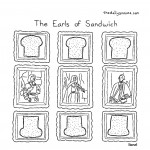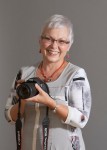For more cartoons, visit thedailysnooze.com.
Images
Creating, choosing kids’ art
A son’s fascination with diggers has led to many other farm-related and animal designs. (photo by Shula Klinger)
When our son, Joel, started to talk, most of what he said was, digger, referring to the large machines that dig earth, so I started drawing them for him. Soon, he became passionate about tractors, so I started drawing those, too – because, like you, I would bend over backwards to meet my child’s needs.
Our Joel has always known his mind. And he has always known that his mother will turn herself into a pretzel when it comes to his education. I also learned how to draw forklifts, dump trucks and specialized mining equipment: road headers, skid steers and face shovels. Essential knowledge for every pretzel-shaped mother.
After several months and hundreds of diggers later, I had a box full of cut-out vehicles. I bought colored card stock and cut out what I hoped were the last 12 diggers. I framed them in an old IKEA frame and put it in Joel’s room, intending to hang it later.
Joel had his own plans, of course. It turns out that 2-year-olds aren’t particularly worried about hanging pictures at the proper height. Instead, his picture sat on the floor where he could poke the glass, name the vehicles and chatter at length to his pictures.
Having thought of his picture as something colorful to fill a spot on his wall, I soon learned that it was a bunch of other things: a teaching aid, a prompt for language development and a favorite companion. It was a comfort, a reflection of his passions and his developing identity. And, sure, it was in his bedroom sometimes, but mainly it traveled to whichever room he was playing in. I never did hang it up.
The diggers were followed by new designs for other families, and countless hours of conversation with them about art. I learned that very young children have strong opinions about shape, color and which medium is best for their project. I learned how art appreciation plays a role in family relationships that is just as significant as the time we spend on outings or reading together. It’s spiritual time, like meditating together, or contemplating abstract ideas, from the biggest ideas to why spiders are able to climb on ceilings without falling off.
The photos I received of toddlers teaching infant siblings about their art showed me that images can be a catalyst for extraordinary reactions in even the youngest kids. I also had my mind changed about what kinds of art children wanted. When a mother asked me if I offered custom versions of my posters, I hesitated. When I realized that she wanted a copy of diggers, “but in girl colors,” I got to work.
When choosing art for our children, there is much more to the decision than meets the eye. Of course, we want the content and color scheme to appeal to our young connoisseurs. We hope that it will complement the design of the room that surrounds it. But, as we see and hear how children respond to this art, it reminds us, as parents, that our own eyes need to open as wide as theirs.
Art appreciation is a kind of literacy and it can lead to explorations of identity, of self-expression, of relationship to and with others. It can elicit feelings of pride in ownership, feelings of attachment and a sense of agency. As she looks at an image, a child’s gaze can be curious, critical, contented, peaceful, excited, inspired. A child may be solving problems, learning about the world or checking his understanding of an issue. Indeed, they have the same types of reactions as adults. Art can engage, stimulate and challenge young minds, which is why we need to take care when choosing pieces for children’s spaces.
Megan Zeni and Kelly Johnson are dedicated to creating fun, educational spaces for children. Both former teachers, their company, Room to Play, helps families make the most of their homes, to create spaces that are stimulating without being cluttered or overwhelming. “Art sets the tone in room; colors, patterns and textures can have a calming or energizing impact,” explained Zeni.
These are all elements to consider, especially as we remember that the art we’re choosing may be the last thing a child looks at as his eyes close at night. Here are some things to think about when choosing or making art for young children:
- Children have favorite colors from a very early age.
- What do they care about?
- Does the art fill a wall and strike a chord?
- Does it inspire the child to touch it, talk to it?
- Does it spark a conversation between your child and you or a sibling?
Questions to think about and ask your child, to encourage a sense of attachment and ownership of the art, include:
- What do you see? What do I see?
- Which colors do you see?
- How many…?
- Which element is the biggest? Which is the smallest?
- Should we frame it?
- Where should we hang it? Should we bother?
Shula Klinger is an author, illustrator and journalist living in North Vancouver.
Razzmatap fills the Rothstein
Gwen Epstein is the second on right in this photo of Sister Suffragette, performed by Razzmatap. The troupe’s upcoming show at the Rothstein has already sold out. (photo from Razzmatap)
The audience at the Norman Rothstein Theatre on June 27 will be treated to a uniquely entertaining show – The Best of Razzmatap.
The local amateur tap ensemble’s members are all women, among them representatives of diverse professions – from a judge, to a teacher, to a physical therapist – and a range of ages, from 40s to 80s. Founder, director and choreographer Jan Kainer talked to the Independent about the group’s roots.
“When my daughter was 7, I started a little class with some of her friends, so she would have an opportunity to tap dance. One class grew to several classes at Kerrisdale Community Centre and, in about 1987, I added an adult class. It was just for fun and fitness. After about six months of class, I asked the adults if they wanted to participate in a Christmas concert. Only one person was willing but, by yearend, the group had worked up the courage to dance in public, and they never looked back…. After we started doing performances and competitions, we decided we needed a name. Everyone put in suggestions, and we voted on Razzmatap.”
The initial core members are still with the ensemble, and several new members have joined through the years, explained Kainer. “The dancers’ average age is 65,” she said. “Our oldest dancer is 86, and I do have to take her health and strength into consideration. I choreograph around the strengths of the dancers in the group, so it forces me to work at making the dances interesting.”
A multiple-award-winning troupe, the upcoming show at the Rothstein, like many Razzmatap events, is already sold out. Kainer thinks the group’s success is largely due to her dancers’ obvious delight on stage. “My group has learned over the years how to tell a story and how to express the joy they feel when dancing. I think it shows.”
One of the dancers, Gwen Epstein, shared her enthusiasm with the JI. “Our teacher Jan Kainer is wonderful,” Epstein said. “When she works on new dances, she tries to give everyone a small solo, to showcase what the individual dancers do best, but, most of the time, we dance as a group, and everyone participates in almost everything.”
Epstein joined Razzmatap about 20 years ago but, like Kainer, she has danced most of her life. “I always liked dancing,” she said. “My mom was a ballet teacher. Of course, I started with ballet classes but I liked tap dance better.”
She took tap dancing lessons until high school, then took a break from her late teens to early 20s. When she got married, she resumed dancing and never stopped, not while raising her three children and not while working full time as a microbiologist.
“I was with a couple of different groups for awhile,” she remembered. “When my daughter was 6, I took her to tap dancing lessons and learned that the teacher also had an adult group. I joined it. It was Razzmatap.”
According to Epstein, the group participates in several tap dance competitions every year and usually wins. “We like to compete,” she explained. “We’ve competed in B.C. and in Germany. We also traveled to New York, Chicago and San Francisco for workshops. We danced in Tap on Broadway in New York. It was fun.”
Everything connected to her favorite group is fun for her. “Tap dance is such a happy activity. The music is lively. You dance and you think of Fred Astaire and Singing in the Rain. You want to smile. Even though none of us is very young, dancing makes us feel young. People come to rehearsals and complain – my knee hurts, my back aches, my feet are sore, some wear knee braces – but then we start dancing and we dance.”
The group usually rehearses twice a week for two hours, but now they have increased to three times a week in preparation for the new show, and everyone is excited. “Everyone has to come to the rehearsals,” she said. “We’re all very enthusiastic about the coming show.”
In the June 27 performance, Epstein will appear in nine dances out of 10, but her favorite is the one where she gets to reminisce on stage – in dance, of course. “I perform in my mom’s clothing in that dance, and it makes me think of her. This dance is very important to me, especially now, when she passed away.”
Each dance of Razzmatap is a story, told in music and movement. Some pieces have serious historical connotations, while others invoke a vague sense of nostalgia or memories of bygone eras. Of course, to create the right ambience for such dances, the performers need multiple props.
“We make all our props ourselves,”
Epstein said. “One dance needed human-sized man puppets as our dancing partners. Another needed suitcases. And then there are costumes. Of course, Jan sets the tone, like the color or sequins, but we make them.”
Epstein has quite a collection of costumes by now, from 20 years’ worth of dancing. “I keep them all in labeled boxes. It’s interesting when we have to travel with all of them.”
Epstein enjoys all aspects of performing: the spotlight, the music, the public. “Before the show, you’re nervous, but after, you feel such a thrill,” she said. “And the audience loves our shows. They are smiling, laughing…. I like entertaining people. When I was young, I didn’t think to make dance a career. I still think it’s nice to have a good job and a hobby you love, but if I had another chance, I might have chosen to be a professional dancer.”
Olga Livshin is a Vancouver freelance writer. She can be reached at [email protected].
Driverless cars one step closer
Prof. Zvi Shiller in the RAV Lab. (photo from israel21c.org)
Within a few years, you may be traveling in a car with nobody at the wheel. Whether you call it an autonomous, driverless or self-driving vehicle, this automobile of the near future needs a host of complex components, some now under development at Israeli companies and academic laboratories.
“You will be able to go to, let’s say, Paris or Tokyo, rent a car, swipe a card and tell it where you want it to go. You won’t have to know the area or the traffic rules,” explained Prof. Zvi Shiller, founder of the department of mechanical engineering and mechatronics at Ariel University and director of its Paslin Laboratory for Robotics and Autonomous Vehicles (RAV Lab).
The biggest benefit will be fewer traffic accidents than we have today – which cause more than 30,000 casualties annually in the United States alone – by eliminating human error in driving. But that requires a very, very smart car.
In the RAV Lab, Shiller and his students are developing algorithms that will automatically modulate speed and handling in response to constantly changing, unpredictable road conditions. Driverless cars will need this capability to meet future safety regulations.
“Today’s driverless cars, introduced by leading car companies such as Ford, Volvo and even Google, can drive very well on a road that is smooth and flat. Our research is about driving over a surface with bumps, ruts and hills,” said Shiller. “This is much more difficult because you can easily lose stability on that kind of terrain. If you’re driving too fast over a bump, you may jump into the air. You have to know at which speed you can drive safely without losing contact with the ground. You may need off-road driving capabilities less than 10% of the time, but you can’t trust a car that cannot handle those 10%.”
The current research continues Shiller’s work at the University of California-Los Angeles Laboratory for Robotics and Automation, which he founded and headed for 14 years before joining Ariel University in 2001.
At the RAV Lab, Shiller and his students have developed a small mobile robot that manoeuvres between obstacles at high speed, showing how the driverless car would handle itself.
“I haven’t seen a similar robot moving as fast,” said Shiller. “This stems from our ability to compute the optimal velocity that exploits the robot’s motion capabilities.”
A couple of years ago, the lab published their results from testing a simple version of this algorithm against one developed at the Massachusetts Institute of Technology, where Shiller earned graduate degrees in mechanical engineering.
“Our algorithm computes a collision-free path among 70 tightly spaced obstacles in half a millisecond, compared to 500 milliseconds (0.5 seconds) it took the algorithm from MIT,” he reported. “That’s 1,000 times faster!”
RAV Lab’s technology could be one of a few systems for driverless cars to come out of Israel. The different systems address everything from motion planning to cyber-security.
Among the companies working on self-driving car technologies is Jerusalem-based Mobileye, whose driver-assistance software is already built into approximately 3.3 million vehicles worldwide. Mobileye reportedly is collaborating with American electric car manufacturer Tesla on developing its driverless vehicle.
Shiller said that one of the most difficult functions to automate is the 3-D mapping system to take the place of human perception in identifying and avoiding moving and stationary hazards in the car’s vicinity.
“Researchers are still working on this,” he said. “Once we map the region around the vehicle, we can use this information to do the next part, which is planning the vehicle’s motion. That’s where my research comes in.”
Making life easier
Over the years, Shiller’s students have produced robots that climb stairs, clean windows, operate wheelchair lifts, dispense pills, push baby strollers uphill, turn pages and accomplish other everyday tasks. They’ve built up a portfolio of almost 90 robotic products over the last 10 years to solve daily life problems in a futuristic way. “Some of these are world firsts,” said Shiller.
The RAV Lab’s research has been supported by Israel’s ministries of science, transportation and defence, the Israeli Space Agency, General Motors and the Paslin Foundation.
As head of the Israeli Robotics Association (IROB), Shiller is optimistic that Israel can become a world leader in smart robotics.
“Quite a few of the Israeli robotics companies are world leaders in their fields,” he said, citing examples such as Robomow, the Dolphin swimming pool cleaner, the SpineAssist surgical device, Mobileye and the ReWalk exoskeleton.
“The research we do in Israel is state of the art,” said Shiller. “I believe that if we build upon the infrastructure developed over the last 25 years in the remarkable Israeli high-tech industry, we can become world leaders in robotics as well.”
For more information, visit ariel.ac.il/sites/shiller/ravlab.
Israel21C is a nonprofit educational foundation with a mission to focus media and public attention on the 21st-century Israel that exists beyond the conflict. For more, or to donate, visit israel21c.org.
Five-minute charger
StoreDot’s technology would enable drivers to charge their car batteries in less time than the company needs to explain how it works. (screenshot from israel21c.org)
StoreDot made headlines when it unveiled its prototype instant phone battery charger at last year’s Microsoft ThinkNext exhibition in Tel Aviv. The flash-battery/flash-charger unit could be available on smartphones by the end of this year. And, at the 2015 ThinkNext in early May, the Israeli company announced that it intends to demonstrate its five-minute ultra-fast-charge car battery next year.
This groundbreaking technology would enable drivers to charge their car batteries in less time than StoreDot needs to explain how it works.
StoreDot specializes in cost-effective, environmentally friendly nanotechnologies using organic materials that increase electrode capacitance and electrolyte performance. This is the recipe for making batteries that can be fully charged in minutes rather than hours.
While competitors in the electric-vehicle space seek to increase mileage per battery charge, StoreDot is focusing on dramatically reducing charging time.
“This is part of our larger initiative to commercialize a proprietary game-changing technology of fast-charging batteries that would transform the lives of smartphone users as well as drivers,” said StoreDot chief executive officer Doron Myersdorf.
The privately owned StoreDot, incorporated in Israel in 2012, also announced the opening of its new facility in Herzliya, housing an organic chemistry lab, battery material development lab and R&D battery production line.
Israel21C is a nonprofit educational foundation with a mission to focus media and public attention on the 21st-century Israel that exists beyond the conflict. For more, or to donate, visit israel21c.org.
הורה ליצרניות הסיגרות לשלם …
הורה ליצרניות הסיגרות לשלם למעלה מ-15 מיליארד דולר. (צילום: Andrew Magill via commons.wikimedia.org)
התביעה הגדולה בתולדות קנדה: בית המשפט העליון בקוויבק הורה ליצרניות הסיגרות לשלם למעלה מ-15 מיליארד דולר למעשנים
בית המשפט העליון של מחוז קוויבק הורה לשלוש יצרניות סיגריות הגדולות ביותר קנדה, לשלם 15.6 מיליארד דולר למעשנים. זאת לאור הנזקים הכבדים שנגרמו להם מעישון. מדובר בתביעה יצוגית בהיקף הכספי הגדול ביותר בהיסטוריה של קנדה עד היום. כצפוי שלוש יצרניות הסיגריות אימפריאל טובקו קנדה, ג’י.טי.איי מקדונלד קורופרשיין ורוטמנס-בנסון אנד הדג’יס אינק, הזדרזו כבר והודיעו כי יערערו על פסק הדין שפורסם לפני מספר ימים.
ההליך המשפטי המורכב נגד חברות הסיגריות החל לפני כשלוש שנים. התביעה מתייחסת לנזקי העישון שנגרמו למעשנים בחמישים השנים האחרונות. בפועל מדובר בשתי תביעות שאוחדו: הראשונה של כמאה אלף מתושבי קוויבק שחלו בסרטן עקב העישון וחלקם כבר נפטרו, והשנייה של כתשעה מאות אלף מתושבי קוויבק שמכורים לעישון סיגריות.
בפסק הדין ציין בית המשפט העליון כי ליצרניות הסיגריות אחריות ישירה לנזקים שנגרמו למעשנים, בזמן שהן בחרו שלא לעדכנם בדבר נזקי העישון הכבדים הצפויים להם. הנתבעות טענו מצידן כי המעשנים היו מודעים לנזקי העישון שצפויים להם, וכן כי הסיגריות נמכרות בקנדה באופן חוקי ובאישור הממשלה הפדרלית.
יצויין כי בית המשפט לערעורים של מחוז אונטריו דחה לפני מספר ימים, בקשה של יצרניות הסיגריות לבטל תביעה נגדן. ובכך ניתן אור ירוק להמשיך בתביעה מצד ממשלת אונטריו נגד חברות הסיגריות שהיקפה לא פחות מחמישים מיליארד דולר. גם במחוזות של בריטיש קולומביה וניו ברנזוויק הגשו תביעות דומות לבתי המשפט המקומיים, נגד יצרניות הסיגריות. ואילו בשאר המחוזות בקנדה גם נפתחו הליכי תביעה שעדיין לא הגיעו לבתי המשפט.
ועוד בנושא המלחמה ביצרניות הסיגריות: בחודש מאי הוקמה קרן צדקה של המיליארדר היהודי-אמריקני, מייקל בלומברג, לשעבר ראש עיריית ניו יורק, כדי לסייע לממשלות ברחבי העולם להילחם בתעשיית הסיגריות. הקרן אמורה לסייע למדינות שמתקשות לצמצם את העישון, באמצעות אספקת יועצים משפטיים לתמיכה בחקיקה נגד יצרניות הסיגריות. תקציב הקרן של בלומברג ארבעה מיליון דולר בשלב זה, ומובטחות לה תרומות מהקרן של ביל ומלינדה גייטס.
לפי הערכות בארגוני הבריאות העישון גרם למותם של עשרה מיליון איש במאה העשרים, והוא ויגרום למותם של מיליארד איש במאה הנוכחית.
הכלב הוא חברו הטוב ביותר של האדם: כלבת לברדור עזרה לילדה להעיד בבית המשפט
לראשונה בקנדה נעשה שימוש בכלב כדי לעזור לעדים במצוקה להעיד בבתי המשפט הפליליים. כל גורמי האכיפה, השפיטה והעובדים הסוציאליים מציינים בחיוב רב את השימוש בכלבים לראשונה לצרכים יחודיים אלה.
ילדה שחוותה תקיפה מינית ונמצאת בטרומה קשה מאוד נעזרה בעדותה לפני מספר ימים בבית המשפט המחוזי בעיר סרי, בכלבה בת שבע מסוג לברדור צהוב העונה לשם קאבר. הכלבה ממשרתת במשטרת העיר דלתא מאז 2010. השימוש בכלבה בעת הדיונים בבית המשפט התאפשר, לאחר שהשופט בתיק אישר את בקשת פרקליטות המדינה להיעזר בה.
ברגעים הקשים במשפט כאשר קורבן התקיפה המינית התקשתה לתאר מה עבר עליה עת הותקפה, היא חיבקה וליטפה את קאבר שהייתה צמודה לרגליה, ופשוט הרגיעה וניחמה אותה כל הזמן.
במסגרת ניסוי במשטרת דלתא בשלוש השנים האחרונות, קאבר הובאה לחקירות של קורבנות של מעשים פליליים, כדי שתעזור להם להירגע בזמן שמסרו את עדותם. לאור הצלחתו של הניסוי היוצא דופן הזה, הוחלט כאמור לראשונה להיעזר בכלבה גם בין כתלי בית המשפט. גורמים שקשורים במשפט הביעו סיפוק מהפתיחות שבית המשפט גילה כאשר איפשר להשתמש בקאבר.
Scratching below the surface
David Bloom (photo from Theatre Plexus)
There are a few remarkable things that one notices when looking at the press material for Scratch, which is being presented by Theatre Plexus at Havana Theatre until June 13.
First, the play itself. Part of the story is in its title, which refers to the protagonist, a teenage girl who loses her mother at the same time as she is dealing with an egregious case of head lice. The other part is in the script by Charlotte Corbeil-Coleman: the original mounting of the production by Toronto’s Factory Theatre in 2008 was nominated for the Dora Mavor Moore Award for outstanding new play.
Second, Theatre Plexus. A relatively new company, it has gathered a small but experienced cast and production team for this show, its third.
“Theatre Plexus started somewhat organically, born out of the necessity of having an umbrella under which to put my personal projects,” explained actor and producer Caitlin McCarthy. “The first show I produced in Vancouver was 8 Girls Without Boyfriends in 2013, but it wasn’t until the following year when I applied for the Vancouver Fringe that I came up with the name. I was performing a show I had written, called Saudade. It occurred to me that I had a mandate (personal and professional): it was important to me to produce work with a strong female voice, and I preferred intimate theatre spaces. I know a staggering number of talented female actors who just don’t get stage time in Vancouver as often as they should, and I want to help remedy that. Scratch has four women in it out of a cast of six, and these women have scenes together that aren’t just related to a male protagonist. In fact, it’s a young, female protagonist.”
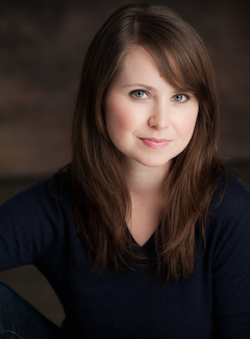
McCarthy plays that young protagonist, Anna, and it was one of the aspects that drew her to the play.
“I picked up a copy of Scratch because I liked some of the monologues – as an actor, I am always looking for good Canadian monologues, and Charlotte Corbeil-Coleman is based in Toronto. I was struck by how tender the play is – and how it presents grief from multiple angles. I also like that the play has a sense of humor and, though it is a play about loss, it is ultimately uplifting. Also, as I mentioned, there are four women in it (and, of course, two wonderful men) and I am an unapologetic feminist when it comes to choosing and casting plays.”
The co-producer of Scratch is Stephanie Izsak, who is also playing the character of Madelyn. Izsak is one of the many members of the production team affiliated with Langara College’s professional theatre training program, Studio 58. This is another remarkable aspect of the local production.
“Steph and I knew each other from Studio,” explained McCarthy of the connections, “and we approached the incredible Genevieve Fleming to be our director – I had gone to school with her…. Eileen Barrett did go to Studio, but I knew her from a playwriting group, Genevieve had seen a lot of Markian’s [Markian Tarasiuk] work while he was a student, we all knew David Bloom as the solo show teacher, and Jeff [Elrick] was recommended by the faculty as he’s still a student. So yes, there is a Studio 58 community to easily draw from, but we didn’t exclusively cast from a Studio pool. I feel so lucky to have Tamara McCarthy and Flo Barrett on board – now that I know them, they will definitely be part of the community I try to work with!”
The process from idea through casting to opening night on June 4 has taken some time, said McCarthy. “Steph approached me two years ago to work together, and I thought of Scratch as a project we could do. It took us a long time to find a venue we liked before we decided on the Havana. I wish there were more independent venues in Vancouver! The lack of space in this city has certainly given rise to some very creative site-specific theatre, but I wish there were more small, traditional theatre spaces to do plays.
“Once we booked the Havana (back in November), it all started to fall into place. We assembled this wonderful group of like-minded artists who felt like the play resonated with them, and we got everything in order for rehearsals to start.”
One of those artists is the aforementioned Bloom, who is a playwright, director, actor, producer and teacher, with a wide range of theatre and television credits, and a Jessie award for Palace of the End with co-directors Katrina Dunn and Mindy Parfitt.
“When Genevieve Fleming asked me to be in Scratch, I said yes very quickly because I liked the writing, and I knew that several scenes would be challenging to play,” Bloom told the Independent. “The other reason I said yes, though, was that I like and admire all the people involved in the project. Four of them are former students and our stage-manager/lighting designer is still one of my students. Theatre Plexus is a fledgling theatre company whose mandate is to do intimate plays with a strong female voice, in small spaces. I’m working with a great group of smart, talented people. How could I possibly say no?”
Bloom said he got into acting “by accident” in Grade 10, as a favor to a teacher.
“In elementary school, I had written and performed sketches with friends,” he explained, “but by high school, I had decided to be a writer; acting was not on my radar. Our drama teacher was short on men for a production of Twelfth Night and he asked me to take on the small role of Sebastian. I was not a popular kid, and I got laughs and applause. It was like catnip to me. I felt a rush during those two performances stronger than any drug. The truth is, I got into acting for exactly the wrong reason: ego gratification. I’ve never had that feeling quite like that again, and it’s no longer what I look for from theatre.
“At a certain point in my 20s, I came to believe in theatre as a spiritual/humanist practice. (The history of the art form has often been deeply entwined with various societies’ religious practices, as well as a way of channeling difficult, dangerous and thrilling ideas.) One of my more embarrassingly naive statements in my early 20s was, ‘Acting is like a priesthood. It’s like practise for being human!’ I understand how ridiculous and self-important that sounds. Luckily for my mental health, I’m also drawn to theatre’s ability to skewer pomposity, especially in myself. There’s something very freeing about being willing to look like an idiot in front of thousands of people.”
“There’s a sense of community that happens when a group of people with limited resources decide to work together to make a performance. It’s intimate and intoxicating.”
Bloom produced his first production at 17. “Nobody had told me that I couldn’t do it, so I did. I’ve continued in that vein ever since. I’d fall in love with the idea of a show, invite friends to my house to talk about it, and the group would create its own momentum that drove us to produce shows in crappy little spaces (the Firehall before it was a theatre, on the set of other people’s shows at midnight, whatever was available). There’s a sense of community that happens when a group of people with limited resources decide to work together to make a performance. It’s intimate and intoxicating. The people involved develop a sense that they’re part of something bigger than themselves. Like most human endeavors, it’s an illusion,” he said, referring to Waiting for Godot, which examines human beings’ need to try to “create meaning for themselves in a meaningless universe.”
This need led Bloom, among other things, to start his own company. “Humans are social animals and we crave a sense of belonging; we need to believe our lives are meaningful. As a result, we’re easily manipulated (street gangs, political parties and xenophobic movements all manipulate that need). It’s also a source of community, sacrifice and some of the best qualities of humanity. I bonded with a group of people who shared my obsession and formed the Grinning Dragon Theatre Company in 1991. We changed our name to Felix Culpa about 15 years ago. Latin for “happy fault,” it is a reference to eating from the forbidden tree of knowledge (my co-director Linda Quibell is a very lapsed Catholic). The focus of the company’s work is the power of language and its unique ability to explore complex subjects such as morality, beauty and the subjective nature of truth.”
Bloom said he has been teaching since 2000, and it suits him “to a T.” The students have to create a one-person show and perform it before they graduate from Studio 58. “I feel blessed to have this job,” said Bloom. “It means that once a week, eight months a year, I have to think about what theatre is, how many different forms it can take and also how to solve specific challenges brought up by the imagination of wonderfully talented young minds. They regularly do work that astounds me. Then they go out into the world and, within a few years, many of them are far more successful than I am. I guess there’s a kind of legacy in that. Also, for awhile, they think I’m really smart, and that brings me right back to the egocentric pleasures that got me into the profession in the first place.”
A member of the Jewish community, Bloom described his family as “secular, intellectual, socially conscious.” He said, “My father is one of Canada’s great physicists. His sisters are, respectively, a mathematician who devoted most of her career to studying how math is taught (not well, in her opinion) and a school principal who pioneered methods of working with disabled children. They grew up on St. Urbain Street and other streets in that Montreal neighborhood, and they all went to Baron Byng High School.
“My father doesn’t remember Mordecai Richler from the school, but when my aunt met him, Richler remembered my father, something I get a kick out of. Long before I read The Apprenticeship of Duddy Kravitz, my father had told me all the stories in the first chapter about ‘Flanders Field’ high school (for example, the teacher who would start each year asking the students, ‘How does a Jew write the letter S?’ and then draw a $ on the blackboard).
“Much of my work is an attempt to understand how human beings can treat each other so vilely. I am often attracted to artistic work that goes to very dark places. I’m also drawn to stories about people who are not accepted by mainstream society, whether they be Jews, queers, radical thinkers, dissidents, melancholics, eccentrics, Muslims, the list goes on.”
“It’s a little morbid,” continued Bloom, “but I first felt deeply Jewish watching an episode about the Holocaust on the amazing BBC documentary series World at War. I realized that Hitler wouldn’t care that we weren’t religious, didn’t follow the dietary laws, that my mother had converted when she married my father. Something about being the ‘other’ landed for me that afternoon and I was stricken. On many levels, the rest of my life has been colored by that. Much of my work is an attempt to understand how human beings can treat each other so vilely. I am often attracted to artistic work that goes to very dark places. I’m also drawn to stories about people who are not accepted by mainstream society, whether they be Jews, queers, radical thinkers, dissidents, melancholics, eccentrics, Muslims, the list goes on.
“My father told me that his mother sent him off to school every day with the admonition, ‘Ask some good questions!’ He explained to me that you would get the best out of your teachers if you challenged them and their ideas. It was acceptable, even essential, to challenge intellectual (and other) authorities because it would make them work harder. I was often a trial to my teachers, as you might imagine, but the best of them had a deep impact on me.
“There is a long history (one might say a talmudic history) of Jews being argumentative, especially with people we love. I consider myself part of that tradition. I love that about us as a people, and I love our love of literacy and our tendency to be stubborn and tenacious. But my instinct to challenge extends to challenging actions of myself, my fellow Jews, the state of Israel and the whole patriarchal, monotheistic basis of the religion…. There are probably many Jews who would not consider me a ‘real’ Jew,” he concluded, “but I believe myself to be true to our culture and the values of intellectual and spiritual inquisitiveness that have made us simultaneously unpopular and essential around the world for thousands of years.”
Tickets for Scratch are $18, with Saturday matinées $10, and are available at brownpapertickets.com. Partnering with Theatre Plexus on the production is the Living Through Loss Counseling Society of British Columbia. “All of the proceeds collected will go to counseling and group therapy for women at risk,” said McCarthy. “It’s very important for me as a producer to question what my contribution is to society – larger than just the theatre community. Grief is such a central part of this story and an inevitable part of human life and I believe this play has the potential to unite people in processing a very universal experience. Because what else is theatre for than to witness our own humanity and bring us closer together?” LTLCS will be holding a talk-back on Tuesday, June 9.
Promoting new dance
Dance Centre’s 12 Minutes Max features works from five up-and-coming choreographers on June 12. Pictured here is Con8 Collective: Charlotte Newman, left, and Georgina Alpen. (photo by Andy White)
An abundance of riches. Scotiabank Dance Centre’s 12 Minutes Max on June 12 showcases the talents of five up-and-coming choreographers – three of whom have Jewish community connections.
Started in 1994, 12 Minutes Max was redesigned and relaunched last year, “with a strong focus on choreographic development, critical feedback and dialogue.” In a season, there are three modules and the June show features artists selected from these sessions, with each performance lasting 12 minutes or less. Among the artists featured are Caitlin Griffin, Charlotte Newman (Con8 Collective) and Naomi Brand.
Griffin was featured in the JI last August for a piece that was influenced by her time in Israel in 2013 with the Kibbutz Contemporary Dance Company, as part of its Dance Journey (Masa) program.
An exploration of the impact of war on women, what was then called The Way They Walked Through the World featured three dancers, and pairs of army boots played a central role. In 12 Minutes Max, Griffin’s work is performed by Delphine Leroux and set to Bach’s Klavierbüchlein für Wilhelm Friedemann.
“The work has evolved significantly from last September’s showing in several ways,” Griffin told the JI. “The process I went through of collecting choreographic material and experimenting with the boots has distilled my areas of interest and inspired new curiosity about the themes of conflict and femininity. While I am still working with the boots in other offshoot projects, in this incarnation, here or there focuses on the established movement vocabulary, transplanted into a classical music environment without boots. It has become a study of the potential within the movement. It is the development of one layer of my continued interest in the material.”
Griffin said The Way They Walked “served as an invaluable project to create a sketch of my interests and goals in this stage of my artistic development. Since then, I have been selecting small seeds from within that larger sketch and developing them into their own short solos. Ultimately, I may use them in combination in a more developed, longer work, but for now I am learning a lot by seeing them as individual studies to explore and cultivate my creative process.”
Con8 Collective’s Newman is new to the JI. Born and raised in Seattle, she moved to Vancouver to study at Simon Fraser University, graduating last year with a BFA in dance. She told the JI that she hopes to call Vancouver home “for the foreseeable future.”
Con8’s contribution to 12 Minutes Max is Vanilla to the Touch. Created and performed by co-artistic directors Newman and Georgina (Gina) Alpen, in collaboration with Robert Azevedo and Elliott Vaughan, it is described as “a quick-thinking, tongue-in-cheek look at growing up in West Coast suburbia, pulling from experiences of bras, boys, rolled-over jeans, juice boxes and more.”
“Like many young girls, I started dancing around the age of 3 and simply never stopped,” Newman said about the beginnings of her career. “In the past 20 years, I have had amazing opportunities to work with varying groups of dancers, in the context of performances, festivals, site-specific creation, music videos and more. I am especially passionate about choreography. I love investigating movement through the lens of our own physical limitations and strongly believe in the power of sharing ideas, concepts and questions through sharing movement.”
Newman said she “grew up with many cultural connections to Judaism.”
“I have many fond childhood memories of Chanuka dinners of endless latkes, Passovers with friends and Shabbat dinners at my grandparents’ house,” she shared. “Only in the past few years, having moved away from my family and many of these rituals I took for granted, have I become more cognizant and questioning of this identity – how do I want to bring Judaism into my own life? On this journey of exploring my own Jewish heritage, I had the amazing opportunity to join in the gift of Taglit-Birthright on a 10-day trip to Israel in May of 2014. The trip was eye-opening, thought-provoking, inspiring and pushed me to continue investigating how Jewish culture fits into my life as young adult – a question I’m still answering.”
She’s also exploring dance, of course, and its manifold permutations and meanings.
“Con8 is a play on the word ‘connate,’ meaning existing from birth and uniting to form a single entity,” she explained. “Gina and I feel these definitions truly encompass the collective’s artistic values – we strive to constantly explore through an innate creativity and unite the collective’s collaborators to make a stronger body of work as one.
“We also embraced the idea of a ‘con,’ meaning a confidence trick. Throughout our choreographic process, we often explore physical games, tricks and rules that lead to very specific movement choices and rhythms, leading to secrets within the performance that the audience will never see.
“Among many similarities,” she concluded, “we share the same birthday – May 8.”
Con8 leans toward “extremely detailed and stylized pedestrian movement that has been brought into the framework of dance performance,” said Newman. “Tight unison, rhythmical timing and a playful attack to serious movement exploration complement this movement vocabulary.”
She said, “Vanilla to the Touch began months ago as a radically different idea. With each new process, Gina and I use rehearsal space as a blank slate – in the beginning of a process, no idea is knocked down and, in a few minutes, we’ll be tossing out ideas one after the other as fast as we can. This process leads to hours of ultimately discarded material, many physically impossible and improbable proposals, and the usual bruises and bumps. We feed off of the other’s energy so hungrily, every rehearsal feels like play. In the midst of this process – around late February – we realized we had about four hours of movement to mold into 12 minutes, thus beginning the second phase of trying on, molding or discarding existing movement as we narrow our vision.
“In Vanilla to the Touch, as we are both performing the entire time, we relied on the eyes of collaborators for their outside perspectives and questions. Through the constant process of cutting, reconstructing and questioning, each movement has a meaning and each phrase was chosen with an exact specificity in mind.”
Unlike Newman, fellow Jewish community member Brand didn’t start dancing at a very young age.
“I danced a bit recreationally and in my teens was a part of a dance group run by a contemporary dancer who focused on modern dance and contact improvisation and got us choreographing on each other,” she explained. “I didn’t take a ballet class until I was 18 and so I often feel that I came to dance technique late.
“My interests in dance have always been diverse. A mentor of mine instilled in me early the importance of having a wide range of skills in order to increase your chances of being successful in the art form and so I have pursued dancing, performing, choreography, teaching and writing in order to have many avenues. I attended the dance program at the University of Calgary, where I earned my BA and an MFA in choreography, and where I also taught for a number of years after graduating.”
Originally from Toronto, Brand said, “I grew up with a secular Jewish identity. I recognized early on that a disproportionate number of artists, writers and progressive thinkers that I admired were Jewish, and that there was a connection between Jewish culture and creative thinking. My parents raised me with very strong values for learning, encouraging me to ask lots of questions and be curious, and also for social justice, family and community, values that I attribute to Judaism. These are values that have permeated my work as a dance artist. I try very consciously to make work that speaks to the relationship between the individual and the community. In my teaching practice, I encourage students to be inquisitive and inclusive, and use dance as a metaphor for how we could be in the world.”
Brand moved to Calgary when she was 19. After 10 years in the city – where she was a recipient of the 2012 Lieutenant Governor of Alberta Arts Awards Foundation’s emerging artist award – she said, “I was looking for a change, new opportunities and challenges, and so I relocated to Vancouver in 2013.”
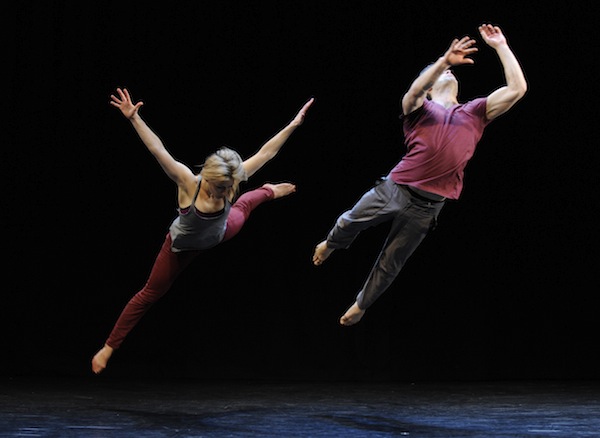
For 12 Minutes Max, Brand is presenting Re:play, performed by Walter Kubanek and Hilary Maxwell. It is described as “an intricate duet that looks at action and reaction in the space between two bodies.”
In addition to being a choreographer, Brand is a writer, as well. “I think that my process in writing and in choreographing are very similar,” she said. “A lot of my training has been as an improviser and so I am most comfortable in the initial stages of generating ideas, jotting things down and spewing material out. Both choreographing and writing are about problem-solving to me. Once I have material to work with, it is about piecing things together, arranging, rearranging and searching for some kind of logic in what I have created. It’s like figuring out a puzzle, when at first you see a perhaps incompressible mass of ideas, words or moments and, then, through playing around with it, a structure or logic reveals itself. I rarely know what exactly it is that I want to say until it is made.”
Brand is also on the board of the Training Society of Vancouver, which has as its focus the quality and sustainability of contemporary dance.
“The field of dance is changing just as culture is changing,” she said. “What it means to be a professional dance artist today is completely different from previous generations, where the company structure was pervasive. Nowadays, everyone has to forge their own path and, in Vancouver, I see many fabulous examples of dancers with tons of drive pursuing their work and making their own opportunities. I have always been interested in being connected to dance from numerous different angles, as a performer, teacher, choreography, writer, advocate and administrator. For me, this diversity keeps me interested and engaged and able to keep perspective on my work.”
12 Minutes Max is at the Dance Centre, 677 Davie St., on June 12, 8 p.m. Tickets ($28/$22) are available from Tickets Tonight, 604-684-2787 or ticketstonight.ca. For more information on all the performers and works featured, visit thedancecentre.ca.
Iron, fire meet cool waters
Gregorio Scalamogna (photo by Olga Livshin)
The current double show at the Sidney and Gertrude Zack Gallery has its origins in the two artists’ friendship. “I met with Greg Scalamogna through a mutual friend,” said Miran Elbakyan, an artist-blacksmith and one of the two participants in the show. “I liked his technique – his lines are plastic-like metal.”
“We have similar philosophy in our works,” Scalamogna elaborated. “Miran’s lines flow like paint. We don’t restrict ourselves, [we] let our materials speak.”
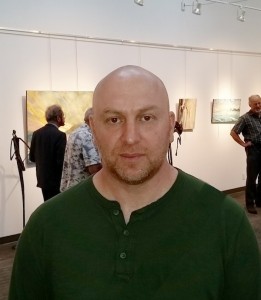
The flowing lines and dynamic energy in both Scalamogna’s paintings and Elbakyan’s sculptures gave birth to the show’s title, Flow, but, aside from that, the two artists are very different, almost opposite in their approaches and subject matter.
While Elbakyan deals with fire and iron, creating tangible objects – sculptures, balconies, staircase rails, wrought-iron gates and other usable items – Scalamogna, a painter, concentrates on water in all its guises. Tame or wild, abstract or real, his waves and waterfalls inhabit the cool bluish-grey palette. His paintings reflect the artist’s fluid personality and his love for water. “I love boating and fishing,” he said with a smile.
Like his beloved water, Scalamogna traveled around the world, flowing in and out of adventures, before settling in British Columbia. He took his first trip when he was 19, a student of the Ontario College of Art and Design.
“I wanted to go to some place sunny,” he recalled. “I bought an air ticket to the Dominican Republic and exchanged my Canadian money at the airport before boarding the plane, but they made a mistake and gave me Mexican money instead of Dominican. Nobody in the Dominican Republic wanted to touch that money.”
As a result, he found himself alone in a foreign country without a cent. Young and proud as only a 19-year-old can be, he didn’t call home and ask his mother for help. “I wanted to do it myself,” he said. To earn some money, so he at least wouldn’t starve, he started painting tourists’ portraits on the beach. He also sold all his spare clothes for the price of a meal or two, and made friends with local people.
“They were poor but they helped me, took care of me,” said Scalamogna. “They were very generous. I couldn’t pay for a hotel, so one guy offered me to spend nights in his home.”
The trip was a success in the end. He made it, paying for his first independent vacation with his art, victoriously returning home a week later. He even brought back souvenirs for his family; he bartered for them with his portraits. “Since then, I wasn’t afraid. I knew I could make it anywhere. I could take on the world.”
Scalamogna spent his last year of college studying in Florence, Italy, and afterwards backpacked across Europe with his artistic portfolio, visiting museums and art galleries, finding work wherever he could. He had a few exhibitions abroad before returning home.
However, like water, which never stands still, he soon felt the urge to move again. This time, he took a bus across Canada. For several years, he lived and worked in Banff, but eventually settled here – the ocean enchanted him.
“I’m an expressionist,” he said. “Nature inspires me. I take photos when I’m on the water, fishing, but my photos are only starting points for my paintings. The photos bring back memories and feelings; they reference a certain time and emotion. There is no visual similarity.”
His paintings also reflect his daily existence. “They are commentaries on my life, my job, my relationships, people around me,” he said. A few years ago, when he was living in Tofino, his paintings were filled with vibrant colors and exploratory energy, with frantic tides and glittering sunsets. Some of them are part of the Zack Gallery show, instantly recognizable, but most of the pieces on display are from his latter Vancouver period. The paintings became calmer and quieter, as if seen through the veil of Vancouver’s rain. “I’m older now, more subtle,” he said.
Like his friend, Elbakyan traveled. He moved from Armenia to Israel and, from there, to Canada, prompted as much by political climate as by other considerations. Like Scalamogna, he, too, found a welcome home here, in British Columbia, and this exhibition is his third appearance at the Zack. “It is always nice to show my art here and get some feedback,” he said, although he admitted that he doesn’t like selling his sculptures.
“I’d rather sell home décor,” he said. “I’m always sorry to see my sculptures go. They are all unique. Even if I try to make a second copy, it has no inspiration in it. The first is always the best.”
The only artist-blacksmith on the B.C. mainland and one of the very few in Canada, Elbakyan is in high demand for those who are not satisfied with mass production, who want an original fence around their house or a one-of-a-kind balcony or some funky furnishing.
Recently, he branched out into the movie industry. His latest movie, Seventh Son, released in December 2014, is a medieval fantasy. “I made swords and shields for it,” he said, “and everything else of metal that their lab couldn’t produce. I also played a smith at a fair. It was fun.”
Elbakyan’s website is bcblacksmith.com; Scalamogna’s is artisticpainting.org. Flow opened on May 21 and runs until June 21.
Olga Livshin is a Vancouver freelance writer. She can be reached at [email protected].
Retiring from the JCC
In her retirement, Jocelyne Hallé plans to keep working as a photographer. (photo by Rachel Lando)
Members of the Vancouver Jewish community know Jocelyne Hallé. For years, she has been the official photographer of the Jewish Community Centre of Greater Vancouver, taking pictures at gala dinners and art presentations. As well, her smiling face and helpful optimism have enhanced the centre’s membership desk and greeted many members, new and old, whenever they enter the building. But, after June 25, she will no longer be there. She is retiring.
“I came to work at the JCC in 2001,” Hallé said in an interview with the Independent. “Before, I used to work for several engineering firms, as a translator or executive assistant, but, by 2001, I grew unhappy with my job. I wanted a change, so I applied to an employment agency.”
She had never thought about a job at the JCC. “My agent took me for an interview but she didn’t tell me where she was taking me,” Hallé recalled. “She just said it would be a new environment for me and that I would like it. She brought me to an interview with Gerry Zipursky [executive director of the centre at the time]. The interview lasted for two hours, the longest interview of my life, and, after that, he hired me to be his personal assistant.”
When she started her new job, Hallé didn’t know anything about the local Jewish community or Jewish culture, or even about working at a community centre in general.
“I asked him why he hired me, a non-Jew,” she said, wondering aloud. “But he said he only wanted his assistant to be competent and sensitive to the situation in the Middle East. I guess I was both, although I don’t remember talking much during the interview. He did most of the talking.”
She admitted that the adjustment period wasn’t easy. “I had to learn so much. But the more I learned about the community and the Jewish culture, the more I fell in love with it. When, in 2005, I went with the others for a working trip to Israel, I felt very comfortable, as if it was home.”
The year 2005 was a milestone for her in many respects. She took thousands of photographs in Israel, and the experience propelled her lifelong passion for photography to a new level. Her photos of Israel adorned an entire wall of the JCC atrium for three years. Her affection for the country and the people reverberated through the images she captured. “It was so gratifying to see people standing in front of that wall, looking at my pictures,” she said. (In 2009, Hallé landed a show at the JCC’s Sidney and Gertrude Zack Gallery. “My friends told me that if they didn’t know better and only judged by my photos, they would’ve thought Israel a green country,” she confided happily.)
Another, sadder event also happen in 2005 – she was diagnosed with breast cancer soon after she returned from Israel. “Cancer changed me, in a good way,” she said. “Contrary to everyone’s expectations, it was a positive experience. I realized what was important in life. I learned who was a real friend and who wasn’t. Before, I was working too much, always tired and heading for depression, but my illness gave me leave to take care of myself.”
She took time to recover and, after two years, returned to the JCC. Her former boss was no longer there, so she started working at the membership desk. “It was a different environment,” she explained. “I finally met many community members and I was away from all the politics. I loved it. Everyone was very friendly and helpful; I felt almost a part of the family.”
She continued learning about the community, immersing herself in the culture and traditions. “By now, I know so much about Jewish ways, people often ask me questions. I explain to them about Rosh Hashana and Shabbat and other celebrations. Many are surprised to learn that I’m not Jewish. To tell the truth, sometimes I feel that I’m kind of Jew-ish. We joke about it.”
In January this year, Hallé turned 60, and decided it was time to retire.
“In the last couple of years, a few of my friends died,” she shared. “It was very upsetting, but I’m alive. I’m ecstatic to be 60. I want to travel, to take some class, to work more on my photography. Recently, I went to Nicaragua for a month; I worked there as a volunteer and I want to do it again. I want to visit Galapagos and Kenya. I might volunteer with the JCC Seniors.”
Hallé is sure that her work for the JCC created an opportunity for her to develop as an artist photographer. With the support and encouragement of her colleagues and friends, she continues to explore her chosen art form. “I have nine photographic events booked this summer, right after I retire,” she said. “I’ll do a bar mitzvah, a wedding, a fundraiser, even a dance festival.”
Hallé’s plans are still in flux, but they expand every day, perhaps enough to fill the next 60 years.
To learn more about Hallé, the photographer, visit her website, jocelynehalle.com.
Olga Livshin is a Vancouver freelance writer. She can be reached at [email protected].

